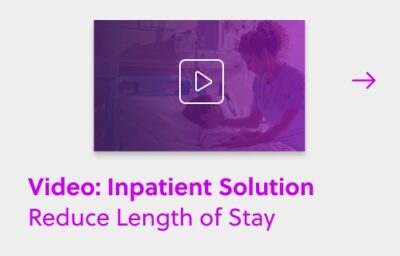Imagine this conversation between a customer looking for breakfast and a manager at a restaurant.
Customer: Hi. I’m starved and would like to get a table.
Manager: Certainly, but we have a wait.
Customer: But half of your tables are empty.
Manager: Yes, but we don’t have anyone to serve you. They’ll be here at Noon.
Customer: OK . . . I notice that there are already other people waiting–did you have an early rush today that you weren’t expecting?”
Manager: No. People always come in this early. We have a wait every morning.
Customer: With open tables and no staff?
Manager: Yes.
Customer: Then I think I’ll go somewhere else.
Manager: No!! Please don’t do that! If you leave without being seated (LWBS), my publically-reported restaurant measures will look terrible!
Customer: Yeah, I’m sorry about that, but I’m hungry. Have you thought about maybe bringing in your staff earlier, to serve customers when they arrive?
Manager: No, we’ve had our current staffing pattern for years, and everyone is comfortable with it. No one wants to change it.
Customer: Sounds like your schedule serves your staff, not your customers.
Manager: Well, we’ve been in the restaurant business for years, and this is the way we do things. Besides, if we bring people in earlier we won’t have as many people later in the day when we’re really crowded.
Customer: Perhaps you’re crowded later in the day because the people who come in early all wait to be seated until the afternoon, then you have to seat them with all the afternoon people, and your operations fall apart. Maybe if you bring staff in earlier you can get the early customers out earlier, then things won’t be as busy later in the day, and not as many people will leave without being seated.
This unusual restaurant dialogue would be funny if it were not also symbolic of the way many EDs run: wedded to a shift structure that brings people in based on something other than when patients arrive.
Take an ED that is like the restaurant above. Nursing has 4 shifts that are 7A-7P, 4 shifts that are 7P to 7A, and 3 swing shifts that are 12 Noon-12 Midnight. Physicians have 6 shifts that are 9 hours each, starting at 7 AM, 9 AM, 1 PM, 3 PM, 5 PM and 11 PM. Everyone thinks this is a great staffing pattern, because the ED always becomes gridlocked by the afternoon, and then staffing is at its maximum
But take a deeper look. In the graph below, patient arrivals per hour is in blue, nursing capacity (assume nurses pick up one new patient per hour on average) is in red, and physician capacity (assume physicians can pick up two new patients per hour) is in green. A graph of patient arrivals, nurse capacity and physician capacity looks like this:
The disconnection is obvious: the ED is not matching supply (of nurses and physicians) to demand (patients). In the 9 AM, 10 AM and 11 AM hours on an average day, people do not go to a bed, but to the waiting room. Just about every clinician and hospital administrator would agree that placing patients in the waiting room is bad for patient care and for the patient experience generally. Yet looking at the schedule above (which is an all-too-common example of Emergency Department staffing), this ED and others like it have been engineered to send patients back to the waiting room.
It’s no secret why the ED is backed up every day in the afternoon. Several of the people who came in from 9 AM to Noon had to sit in the waiting room until staff came in for the noon shift. Then, while staff were getting those patients into beds, more were coming in—and waiting until the first wave was processed. The result: gridlock, almost every day, by 3 PM.
Does this busy ED need more staffing, or just more efficient staffing? With a view of patient mix or acuity, we could make a better determination of whether the ED is overstaffed, understaffed, or appropriately staffed. But the answer to the second question is obvious: without a doubt, the ED could use it’s resources more efficiently. And reconfiguring them costs nothing.
This ED changed both physician and nurse staffing, moving some of the “lunch” crew back into the “breakfast” hour. Without any change in resources, take a look at how the graph of demand (patients) vs. supply (doctors and nurses) is now matched:

Not perfect, but much better. The resources (doctors and nurses) needed to start their shifts closer to when the patient load is increasing, and trail off as the patient load declines. Without adding any more staffing, supply was matched to demand — and the day flowed much more smoothly.
Will this simple analysis work for every day of the year? Probably not, but it’s a decent start. Even in a “breakfast” oriented ED, there will still be days when more people come in the afternoon or evening instead. Those days will be difficult, but there should be less of them if staffing matches arrivals.
To truly solve this problem, a manager needs to be able to understand not just the average or expected arrivals for a given day but also the probability of seeing slightly different distributions of arrivals. In other words, arrivals should be viewed as range of possible outcomes, each with its own probability. Furthermore, these distributions should be forward-looking forecasts, not just analysis of the past few months or years. And finally, we shouldn’t be solving this staffing problem just once or twice a year; we should be revisiting it more regularly, as seasons and disease trends come and go.
If performing all of this analysis sounds like a lot of work, it is. Fortunately, such analytical challenges are well suited for software. Contact analyticsMD to learn more about whether or not you are using your staffing resources most effectively, about the ability to predict your difficult times, and other ways to optimize your ED.


